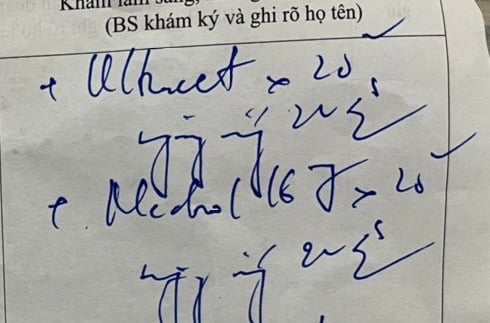Handwritten prescriptions are difficult to read accurately.
According to records from major hospitals, thousands of prescriptions are written per day. At special hospitals, peak times can reach 7,000 - 8,000 prescriptions per day.
Some patients have reported that handwritten prescriptions can be difficult or impossible to read if the doctor writes in a hurry or with incomplete handwriting.

A handwritten prescription that is difficult for the patient to read correctly.
PHOTO: NAM SON
Sharing her experience, Ms. Nguyet (39 years old, in Hanoi) said that during her post-operative check-up, the doctor prescribed her medication. Holding the prescription in her hand, after trying to reason, she read the last line with the diagnosis "stable after surgery", but she could not read the 3 lines of prescription and dosage.
"Perhaps because there are so many patients waiting to be examined by a doctor, the doctor has to write the prescription as quickly as possible. And maybe, the doctor thinks that the pharmacist will figure it out, get the medicine and give instructions to patients like us," Ms. Nguyet guessed.
According to Ms. Nguyet, even with a prescription that is difficult to read, she was still able to buy all the medicine when she went to the pharmacy.
"But I'm still a bit nervous, because I'm not sure if the medicine I bought is the same as the one prescribed, because the doctor knows best. Only when I see my health improve after taking it will I feel secure," Ms. Nguyet shared.
According to Ms. Nguyet, recently most hospitals in Hanoi have very clear and saved orders on computers. This method needs to be implemented at medical facilities to avoid confusion for patients.
In a similar situation to Ms. Nguyet, Mr. Thanh (30 years old) in Dong Da District said that the "bad handwriting" prescription he was given by a doctor in Hanoi was when he went to the doctor due to hand pain from playing sports.
"After the examination and X-ray results, the doctor diagnosed the disease, advised me on my health condition, and recorded the diagnosis in my medical record along with the prescription," said Mr. Thanh.
According to Mr. Thanh, when he arrived at the pharmacy, he could only deduce that the doctor's diagnosis was a sports injury with the abbreviation: "Sports CT". As for the content "16 mg", which was written in the prescription, Mr. Thanh read out...167.
"I couldn't read the name of the medicine, except for the words "20 pills", which I understood meant the quantity needed was 20 pills, but I didn't know what medicine it was. Luckily, when I contacted the doctor again, I received a clear prescription, and I could read the full name, content, and dosage," Mr. Thanh said with a laugh.
Electronic prescriptions are transparent but slow to progress
An expert said that there are currently nearly 250 drugs in the list of non-prescription drugs, out of about 20,000 drugs with registration numbers. Thus, many drugs must be prescribed. The Ministry of Health has issued regulations on electronic prescriptions, linking prescriptions with the national prescription system to monitor the prescribing practice of each doctor, ensuring transparency and accuracy.
On each electronic prescription, the management agency can always access detailed information about the origin of the prescription; view detailed information about each prescribing physician, practice certificate documents, operating facility, etc. Thereby ensuring that the prescriptions generated from the facility are correct, sufficient, accurate, and within the authority of the practice, as well as having a search tool to track inappropriate forms of prescription.
Speaking to Thanh Nien , Dr. Ha Anh Duc, Director of the Department of Medical Examination and Treatment Management (Ministry of Health), said that at today's meeting on April 14, the drafting committee of the circular on outpatient prescriptions proposed that the deadline for implementing electronic prescriptions and national prescription linkage is September 30, 2025, applicable to units with hospital beds. The deadline is December 31, 2025 for all other medical facilities, including pharmacies and private clinics.
Previously, the Ministry of Health had stipulated that the deadline for completing electronic prescriptions with treatment facilities was June 30, 2023.
According to the latest statistics of the Vietnam Medical Informatics Association, currently only 59% of hospitals implement electronic prescriptions and national prescription linkage.
For health stations, this rate reached 77%. The private health sector (general and specialized clinics) had the lowest rate, less than 20% had implemented it.
Source: https://thanhnien.vn/benh-nhan-ban-loan-khi-doc-don-thuoc-viet-tay-185250414191012982.htm


![[Photo] Cultural, sports and media bloc at the 50th Anniversary of Southern Liberation and National Reunification Day](https://vphoto.vietnam.vn/thumb/1200x675/vietnam/resource/IMAGE/2025/4/30/8a22f876e8d24890be2ae3d88c9b201c)


![[Photo] Performance of the Air Force Squadron at the 50th Anniversary of the Liberation of the South and National Reunification Day](https://vphoto.vietnam.vn/thumb/1200x675/vietnam/resource/IMAGE/2025/4/30/cb781ed625fc4774bb82982d31bead1e)

![[Photo] Chinese, Lao, and Cambodian troops participate in the parade to celebrate the 50th anniversary of the Liberation of the South and National Reunification Day](https://vphoto.vietnam.vn/thumb/1200x675/vietnam/resource/IMAGE/2025/4/30/30d2204b414549cfb5dc784544a72dee)




















































































Comment (0)